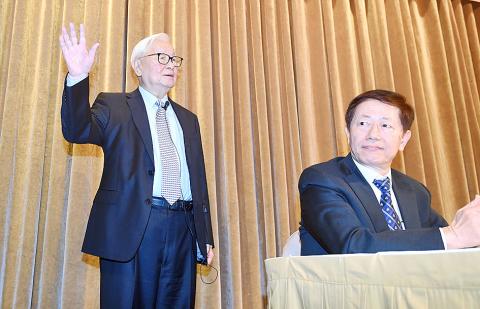Taiwan Semiconductor Manufacturing Co (TSMC, 台積電), the world’s largest contract chipmaker, yesterday posted a record-breaking net profit of NT$343.11 billion (US$11.61 billion) for last year, benefiting from robust chip demand for smartphones and cryptocurrency mining machines.
That represented an annual growth of 2.65 percent from NT$334.25 billion in 2016, according to the chipmaker’s financial statement. Earnings per share rose to NT$13.23 from NT$12.89.
While the pace of growth decelerated from 2016’s 10 percent increase, the chipmaker expects the growth momentum to carry on this year.

Photo: Liao Chen-huei, Taipei Times
This year will be “an above-average year,” TSMC founder and chairman Morris Chang (張忠謀) told investors at his last appearance at the company’s quarterly earnings conference.
Chang is set to retire this summer.
Revenue growth would accelerate to between 10 and 15 percent this year in US dollar terms, following a 9 percent increase last year, Chang said.
That would be faster than the company’s five-year target of compound annual growth of between 5 and 10 percent from last year to 2021.
Chang said he expects growth to be fueled by three of the firm’s growth platforms: high-performance computing (HPC), Internet of Things and automotive.
Replacing mobile phone chips, “HPC chips will grow the strongest due to continuing expansion of AI [artificial intelligence] applications in all electronic devices, as well as continuing demand for cryptocurrency GPU [graphics processor unit] and etc,” Chang said in English.
“The urge to mine cryptocurrency is very strong. The [cryptocurrency] price is very volatile, but the demand since the last year has been very strong. We expect it will continue to be strong,” he said.
“However, we will size the demand carefully,” he added.
Mobile phone chips, the biggest revenue contributor to TSMC, would see little growth this year, he predicted.
Based on Chang’s growth projection, TSMC would again outperform the global semiconductor industry’s projected annual growth of between 6 and 8 percent, and the foundry sector’s annual growth of between 9 and 10 percent this year.
However, due to the smartphone industry’s slow-season effect, TSMC expects revenue to shrink by 8.3 percent sequentially this quarter to between US$8.4 billion and US$8.5 billion.
Gross margin is expected to reach between 49.5 percent and 51 percent this quarter, compared with 50 percent last quarter, TSMC said.
The company’s net profit dropped 0.9 percent to NT$99.29 billion in the final quarter of last year, compared with a record-high NT$100.2 billion in the fourth quarter of 2016.
The company attributed the contraction to a 1.5 percent appreciation of the New Taiwan dollar against the US dollar.
On a quarterly basis, net profit increased 10.4 percent from NT$89.93 billion, the company’s financial statement showed.
To support the company’s growth and customer demand, TSMC plans to spend between US$10.5 billion and US$11 billion this year, mainly on new equipment for 7-nanometer manufacturing and developing 5-nanometer technology.
TSMC is on track to start mass production of its 7-nanometer chips — mostly for smartphones and AI applications — next quarter, TSMC cochief executive C.C. Wei (魏哲家) told the conference.
The 7-nanometer chips are to account for 10 percent of the company’s total revenue this year, Wei said.

In a small town in Paraguay, a showdown is brewing between traditional producers of yerba mate, a bitter herbal tea popular across South America, and miners of a shinier treasure: gold. A rush for the precious metal is pitting mate growers and indigenous groups against the expanding operations of small-scale miners who, until recently, were their neighbors, not nemeses. “They [the miners] have destroyed everything... The canals, springs, swamps,” said Vidal Britez, president of the Yerba Mate Producers’ Association of the town of Paso Yobai, about 210km east of capital Asuncion. “You can see the pollution from the dead fish.

MULTIFACETED: A task force has analyzed possible scenarios and created responses to assist domestic industries in dealing with US tariffs, the economics minister said The Executive Yuan is tomorrow to announce countermeasures to US President Donald Trump’s planned reciprocal tariffs, although the details of the plan would not be made public until Monday next week, Minister of Economic Affairs J.W. Kuo (郭智輝) said yesterday. The Cabinet established an economic and trade task force in November last year to deal with US trade and tariff related issues, Kuo told reporters outside the legislature in Taipei. The task force has been analyzing and evaluating all kinds of scenarios to identify suitable responses and determine how best to assist domestic industries in managing the effects of Trump’s tariffs, he

TIGHT-LIPPED: UMC said it had no merger plans at the moment, after Nikkei Asia reported that the firm and GlobalFoundries were considering restarting merger talks United Microelectronics Corp (UMC, 聯電), the world’s No. 4 contract chipmaker, yesterday launched a new US$5 billion 12-inch chip factory in Singapore as part of its latest effort to diversify its manufacturing footprint amid growing geopolitical risks. The new factory, adjacent to UMC’s existing Singapore fab in the Pasir Res Wafer Fab Park, is scheduled to enter volume production next year, utilizing mature 22-nanometer and 28-nanometer process technologies, UMC said in a statement. The company plans to invest US$5 billion during the first phase of the new fab, which would have an installed capacity of 30,000 12-inch wafers per month, it said. The

ASML Holding NV, the sole producer of the most advanced machines used in semiconductor manufacturing, said geopolitical tensions are harming innovation a day after US President Donald Trump levied massive tariffs that promise to disrupt trade flows across the entire world. “Our industry has been built basically on the ability of people to work together, to innovate together,” ASML chief executive officer Christophe Fouquet said in a recorded message at a Thursday industry event in the Netherlands. Export controls and increasing geopolitical tensions challenge that collaboration, he said, without specifically addressing the new US tariffs. Tech executives in the EU, which is